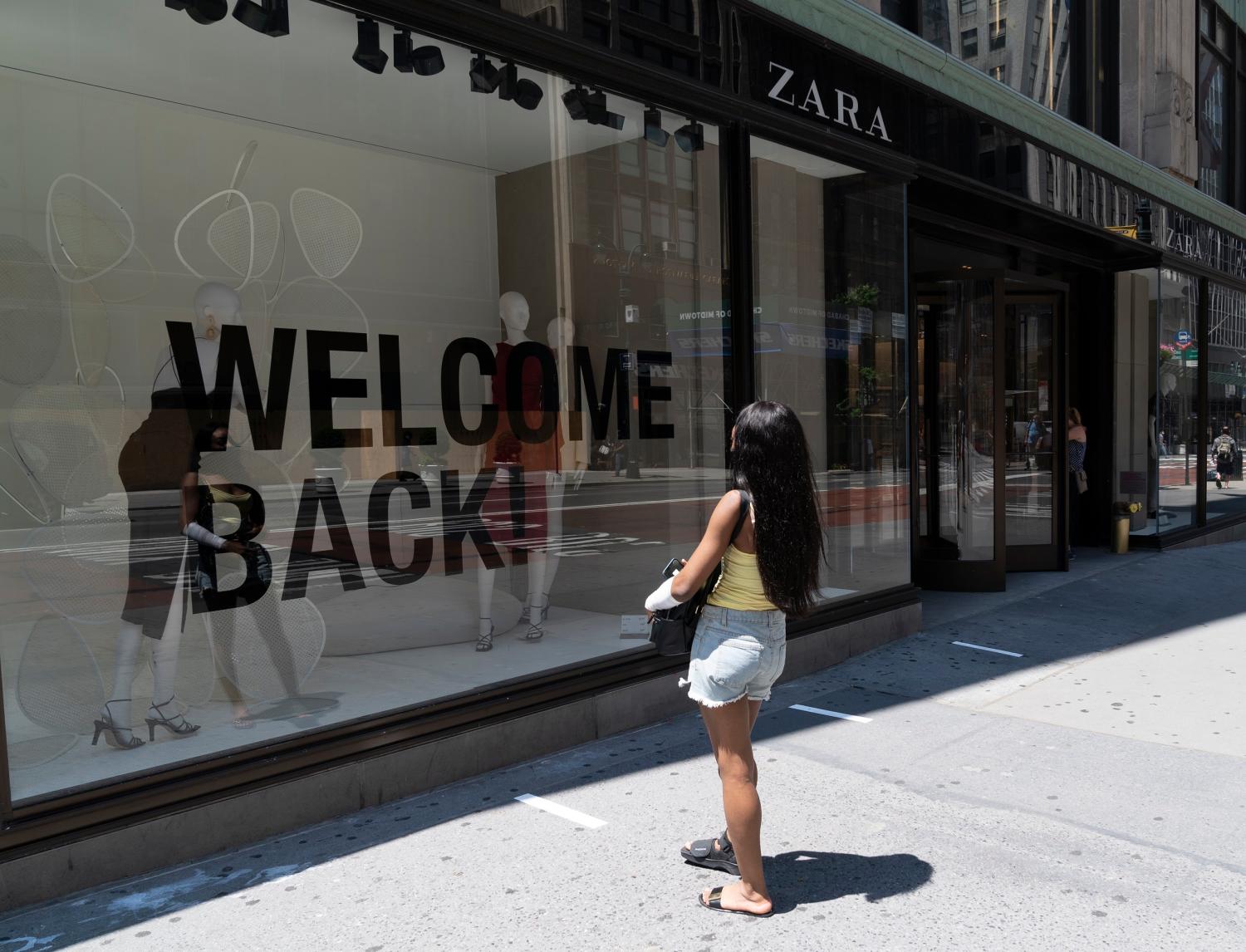The following is an excerpt from Reopening America: How to Save Lives and Livelihoods, a new report where Brookings experts offer ideas to help policymakers protect lives and save livelihoods in the midst of the current COVID-19 pandemic.
 States are beginning to reopen America’s paused, traumatized economy. In the absence of a national roadmap for that transition, governors, regional leaders, and business owners are scrambling. They are downloading general guidance documents from the Centers for Disease Control and Prevention (CDC). They are scouring the world for COVID-19 testing kits. And they’re asking trusted stakeholders what they think about easing coronavirus quarantines.
States are beginning to reopen America’s paused, traumatized economy. In the absence of a national roadmap for that transition, governors, regional leaders, and business owners are scrambling. They are downloading general guidance documents from the Centers for Disease Control and Prevention (CDC). They are scouring the world for COVID-19 testing kits. And they’re asking trusted stakeholders what they think about easing coronavirus quarantines.
This process has been impressive in some cases, but it’s also beginning to create a national patchwork of approaches. With President Donald Trump pushing prematurely to ease lockdowns, early reopening mandates from some state leaders appear to be driven more by politics than data, as many parts of the country continue to see rising caseloads with nowhere near adequate testing capacity.
At the same time, the restart challenge has surfaced thorny logistical challenges, as leaders and business owners get down to the nitty-gritty of developing and implementing specific protocols for reopening. Most notably, leaders and businesspeople are finding that while a consistent, well-distilled consensus exists on public health priorities, a dearth of consistent, well-organized practical advice exists about the business operations side of reopening safely.
How, precisely, should one manage food pick-ups when reopening a restaurant? When and where should temporary barriers be installed to create separation between workers on an assembly line? Trustworthy guidance on such questions first took weeks to become available; then, more recently, it has accumulated haphazardly, and varies in quality. The result is that policymakers and employers alike have been uncomfortably forced to jury-rig as they devise everything from cleaning and employee screening procedures to policies on common areas and vulnerable populations.
This is where the rise of an impressive array of highly detailed region- and industry-specific playbooks and checklists is playing a hugely important role in bringing a semblance of order to the nation’s gradual return to work. With detailed, industry-specific guidance from the federal government still unavailable, a disparate set of corporations, industry associations, regional business groups, and careful states is producing such guidance themselves. Through their own consultations with health experts and business site managers, these consortia are hacking together an often-impressive collection of to-do lists, manuals, and toolkits.
The best of the playbooks are emerging as the core guidance available for helping businesses reopen safely. The good news is that some of the back-to50 work playbooks reflect the best of America’s talent for “bottom-up” local, regional, and private sector problem-solving.
HEALTH CONSIDERATIONS
The multiplying safe-work guides are a response to what’s tricky about the “reopening” moment: While the reopening juncture poses riddles at the intersection of public health and business operations, there exists far clearer guidance on the health side.
The most prominent and coherent advice has flowed out of the health camp, most notably from the CDC’s “Interim Guidance for Businesses and Employers Responding to Coronavirus Disease” and its associated “Community Mitigation” document. These resources are essential to informing any reopening approach, as are excellent reports from the American Enterprise Institute, the Center for American Progress, Harvard’s Safra Center for Ethics, and economists Paul Romer and Alan M. Garber.
There’s a lot of consensus on the public health side of reopening, to the point that it’s easy enough to tick off four well-established criteria for states’ and regions’ readiness to reopen:
- There must be a sustained reduction in cases for at least 14 days.
- Hospitals in the area must be able to safely treat all patients requiring hospitalization, without chaos or lowered standards.
- The region needs to be able to at least test everyone who has symptoms—and ideally many more than that.
- A state should have in place case monitoring, contract tracing, and isolation.
To be sure, no state or region or the nation has yet fully accomplished all of these criteria (though many are still moving to reopen). Nevertheless, the fact remains that the substantial clarity in the public health consensus is an important starting point for return-to-work planning. But that’s only the public health side of the question.
WORKPLACE CONSIDERATIONS
On the business operations side of the matter, the initial paucity of reopening guidance—followed by a proliferation of fragmentary, biased, sloppy, or superficial information—has created a lot of confusion.
What’s more, Trump administration delays and bowdlerization of the release of the CDC’s detailed, industry-specific return-to-work guidelines have further exacerbated the problem, creating a major void for local leaders and businesses in deciding when and how to open facilities such as mass transit, day care centers, and restaurants. With the CDC standing as the de facto regulator in a health crisis, many cities and businesses have felt uncomfortable about reopening.
And rightly so. Rethinking workplaces to conduct business at a time of social distancing is a deceptively complex activity, after all, of the kind the doctor and journalist Atul Gawande identifies in his book The Checklist Manifesto. Given the intricacies of such activities, Gawande notes, it is extremely easy for a well-intentioned professional (or business owner) to miss something, forget a step, or fail to plan properly for every eventuality. Therefore, as Gawande writes, we need checklists and playbooks on how to translate complex public health information into practical business operations.
Which is where the growing number of COVID-19 reopening playbooks comes in—some extraordinary, some mediocre.
By and large there was far too little practical information available about safe operations as discussion about reopening began to spread in April. However, since then has come an explosion of guides and toolkits, often from industry associations such as the National Restaurant Association, the American Hotel & Lodging 51 Association, and the U.S. Travel Association. Scores of these guides are providing a first-order set of basic guidelines in the absence of authoritative federal rules for particular business types. The problem is that some are not always detailed or authoritative enough.
The same variation in quality characterizes many of state and city reopening plans. Mostly released by states determined to reopen despite rising COVID-19 caseloads and a lack of adequate testing, the plans range from the perfunctory to the plausible and prudent. On the perfunctory side, South Dakota’s “Back to Normal” Plan consists of just four airy pages. Nashville, Tennessee, and California have assembled more cautious, calibrated plans. Governor Gavin Newsom of California has done an especially good job of projecting a phased roadmap for adjusting the original safety measures and staging the reopening of 18 specific industries. Newsom has also committed California to cooperate with Oregon and Washington in managing the reopening process.
Beyond these efforts, a number of industries, business associations, and regional leadership networks have distinguished themselves by developing industry-specific guidance. In each case, these organizations have developed and released detailed, carefully considered guides that do what proper CDC reopening guidelines might have done a month ago.
On April 6, for example, the auto seat manufacturer Lear posted a highly detailed “Safe Work Playbook” that provided step-by-step guidance for factory managers on everything from cleaning conveyor belts to social distancing during shift changes. The playbook exudes a can-do rigor and even includes downloadable, editable signage. A new 80-page version contains tips on outreach and communication, draft “welcome back” letters to workers, and checklists for ensuring a site is ready to open. Equally careful and detailed is the “Recovery Readiness” how-to guide released last month by the property manager Cushman & Wakefield.
THE CASE OF INDIANA
Of similar quality is a set of three “playbooks” developed through a collaboration between the Central Indiana Corporate Partnership (CICP), Cummins, and other major Indiana employers. These high-quality documents reflect a surge of emergency problem-solving in Central Indiana and the special potential of regional business organizations to help manage the return to work.
In the Indiana case, high-quality problem-solving on reopening flowed out of CICP’s 20- year existence as a respected forum for CEO dialogue and leadership in the state. Through the course of weekly CEO discussions in March, CICP established a framework articulating the essential elements of any responsible return-to-work policy. Soon thereafter, leaders at Cummins began to develop pragmatic guidelines and clear practices for reopening workplaces.
As a global producer of industrial engines, Cummins has been dealing with the COVID-19 pandemic since January, when hundreds of workers at the company’s Wuhan facilities were subjected to total isolation conditions as China battled the world’s first coronavirus wave. Drawing on this experience, a global team of Cummins engineers, led by CEO Tom Linebarger, worked intensively to produce CICP’s three playbooks for reopening warehouse and production floors, office spaces, and customer-facing service centers.
The first of these playbooks—“Safe Return to Work for Indiana’s Manufacturing, Logistics and Warehousing Sectors”—is designed to be readily accessible and intensely practical. It offers an array of recommendations for varying conditions and danger levels that support employers in thinking through how they can:
- enable social distancing through operating with fewer employees onsite in reconfigured spaces
- protect employees, vendors, and customers through the use of PPE, enhanced cleaning, and other hygiene practices
- manage and communicate with employees and other stakeholders as businesses resume operations while continuing to monitor disease spread.
While these recommendations are written for the manufacturing and warehouse floor, many of them are generalizable to other workplace environments. Companion documents therefore provide the same level of detailed guidelines for Indiana’s office environments and point-of-service operations. All three of the playbooks feature helpful graphics, such as a comparison of various mask options and diagrams of optimal configurations for common areas. Importantly, the playbooks counsel that the best way to ensure appropriate social distancing is for employers to continue to offer work-from-home options for all employees who can productively do so.
In the absence of a national roadmap for a safe reopening of the economy, business leaders, regional leaders, and governors are scrambling— and sometimes innovating—to fill in the gaps. Many are building smart, responsible, and practical checklists and playbooks for restarting America.
Finally, CICP’s role in Indiana as a highly-networked business-leadership hub has ensured that the new playbooks are gaining influence and being used. By leveraging its corporate members and branded initiatives, CICP has been able to disseminate these playbooks to an array of small, medium, and large manufacturers, businesses, tech companies, and other enterprises across Indiana. Results have been positive in terms of both immediate endorsement for use and also through helpful suggestions for improvement. CICP gathered the latter to produce new editions before offering the full set of playbooks to the State of Indiana and Governor Eric Holcomb’s team for further guidance and distribution, as they begin a phased return to work in May and June.
WISE RETURN-TO-WORK PLANS
As to what the best reopening playbooks advice for states, cities, and businesses trying to develop wise return-to-work plans, a few observations suggest themselves:
- Safe reopening is a granular business operations procedure and requires the intense concentration of business owners and operators. Above all, the next phase of the pandemic will require owners and operators to commit to a common vision for reopening, beginning with a commitment to safety.
- Reopening plans should begin with core public health criteria for readiness. All of the high-quality frameworks and plans discussed here allude to core readiness metrics such as the 14-day new caseload, hospital capacity, testing capacity, and case monitoring ability. California lays this out explicitly and carefully.
- Specificity matters in reopening protocols. For that reason, virtually all of the best plans consist of checklists and to-do items. These simple checklists translate general health guidance into itemized, easy-to-follow rules.
- Concern for workers’ well-being and steady communication is critical. The best plans call out the importance of the human side. Lear’s playbook contains an entire section on using surveys, huddles, and town halls to hear the “voice of the employee” and ensure the company remains accountable and safe. CICP’s document includes three sections on human resources issues, including guidance on how to restart communications with workers and accommodating vulnerable employees.
- The best reopening plans are tentative, conditional, and iterative. Property manager Cushman & Wakefield’s how-to guide for reopening is labeled “Version 1.0.” Nashville’s four-phase plan states, “We will only move to the next phase if there is positive improvement/ stability in the metrics for 14 days.” And Lear’s playbook is now on its second edition. This iterative approach is wise because reopening will occur amid radical uncertainty about the trajectory, incidence, and seasonality of COVID-19. 54 For that reason, even the most cautious of reopening playbooks will need to be constantly reviewed and revised in the light of real-world experience.
In the absence of a national roadmap for a safe reopening of the economy, business leaders, regional leaders, and governors are scrambling— and sometimes innovating—to fill in the gaps. Many are building smart, responsible, and practical checklists and playbooks for restarting America.
Almost certainly, this approach is a poor substitute for the existence of an overarching, clearly distilled set of federal guidelines and timelines for America as a whole. With that said, the best of the sub-national playbooks are highly reassuring, and represent the best of America’s knack for decentralized problem-solving. Hopefully, other states, business associations, and businesses will find these playbooks useful as a starting point for their own efforts.







